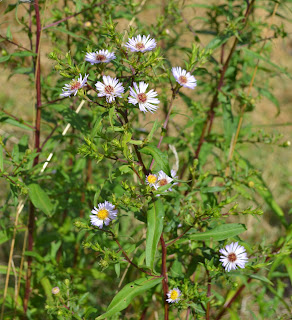21 August 2013 OS Map 175 Reading/Windsor
All day
We
parked in Ferry Lane Wallingford Thames this stretch is still rich in plantlife. Our only real disappointment was not seeing
any greater dodder Cuscuta europaea
at its classic location along this river.
Although we have seen it elsewhere we have yet to find it beside the Thames .
Dragonflies were naturally much in evidence, although many were too
strong-flying for us to get a chance to identify them. We did record common darter, small red
damselfly, and banded demoiselle.
Cholsey Marsh with reed
canary-grass, great willowherb and meadowsweet
Common comfrey
Orange balsam and great
willowherb
Marsh woundwort
Amphibious bistort
Gall of gall-midge Wachtliella persicariae on amphibious
bistort
Brown sedge in Cholsey
Marsh
Reed sweet-grass with reed
canary-grass in front
Pfeiffer's amber snail on
hedge bindweed leaf
Hedge bindweed was
clambering over most of the tall vegetation
Gipsywort
Bean galls of sawfly Pontania proxima on crack willow
Common fleabane
Mine of moth Stigmella salicis in osier leaf
Bittersweet
Gall on meadowsweet caused
by fungus Triphragmium ulmariae
Common skullcap
Hard rush inflorescence;
its narrow stiff grey stems distinguish it from
soft rush
Purple loosestrife
Confused Michaelmas-daisy
has colonised much of the riverbank
Viviparous form of
cocksfoot grass, quite common late in the season
Tufted vetch
Branched bur-reed
The river itself supported few aquatics, given the continuous boat traffic. Away from the bank, these plants were mainly limited to yellow water-lily, unbranched bur-reed and spiked water-milfoil. Close to the bank but still in the water were common club-rush, yellow iris, branched bur-reed, bulrush, great water dock and water-plantain.
Yellow water-lily and its
"brandy-bottle" fruits
Great water dock
Unbranched bur-reed
Common club-rush
Some
way north of Cholsey Marsh, opposite the village of North Stoke
Shortly
after this we passed a boathouse and a wooden platform at the bank of the Thames where there was a quiet pool which had flowering
rush, yellow loosestrife and greater duckweed - all of which may have been
introductions, as we saw them at no other spot.
Here we also saw the river snail Viviparus
viviparus.
Great and common duckweeds
River snail
Flowering rush
After walking under the main road bridge we were on the outskirts of
Hop leaf with mine of fly Agromyza flaviceps
Poplar fieldcap on willow trunk
Water bent with annual
meadow-grass and field forgetmenot
Creeping bellflower
Mexican fleabane and
pellitory of the wall by Wallingford
Bridge
From
the centre of Wallingford we continued north by
the footpath beside the Thames . Here we passed many of the morning's
waterside plants, although not quite so rich.
We added crow garlic to our list.
After a kilometre we decided to turn back, past the bridge and along Thames Street Wallingford Wallingford
Angelica, wild Angelica sylvestris (frequent)
Arrowhead Sagittaria sagittifolia (once)
Balsam, Indian Impatiens glandulifera (once)
Balsam, orange Impatiens capensis (frequent)
Bindweed, hedge Calystegia sepium (abundant)
Bistort, amphibious Persicaria amphibia (occasional)
Bittersweet Solanum dulcamara (occasional)
Bulrush Typha latifolia (occasional)
Bur-reed, branched Sparganium erectum (frequent)
Bur-reed, unbranched Sparganium emersum (abundant)
Canary-grass, reed Phalaris arundinacea (abundant)
Chickweed, water Myosoton aquaticum (once)
Chicory Cichorium intybus (once)
Club-rush, common Schoenoplectus lacustris (occasional)
Comfrey, common Symphytum officinale (frequent)
Comfrey, Russian Symphytum x uplandicum (occasional)
Cranesbill, meadow Geranium pratense (occasional)
Dewberry Rubus caesius (abundant)
Dock, great water Rumex hydrolapathum (occasional)
Duckweed, greater Spirodela polyrhiza (once)
Figwort, water Scrophularia aquatica (occasional)
Fleabane, common Pulicaria dysenterica (frequent)
Garlic, crow Allium vineale (occasional)
Gipsywort Lycopus europaeus (frequent)
Hop Humulus lupulus (occasional)
Horsetail, water Equisetum fluviatile (once)
Iris, yellow Iris pseudacorus (frequent)
Loosestrife, purple Lythrum salicaria (frequent)
Loosestrife, yellow Lysimachia vulgaris (once)
Meadow-rue Thalictrum flavum (occasional)
Meadowsweet Filipendula ulmaria (frequent)
Michaelmas-daisy, confused Aster novi-belgii (frequent)
Mint, water Mentha aquatica (frequent)
Osier Salix viminalis (frequent)
Reed Phragmites australis (frequent)
Rush, flowering Butomus umbellatus (once)
Rush, hard Juncus inflexus (occasional)
Sedge, brown Carex disticha (occasional)
Sedge, false fox Carex otrubae (occasional)
Sedge, great pond Carex riparia (frequent)
Sedge, hairy Carex hirta (occasional)
Sedge, lesser pond Carex acutiflorus (frequent)
Sedge, pendulous Carex pendula (occasional)
Sedge, remote Carex remota (occasional)
Sedge, slender tufted Carex acuta (frequent)
Sedge, spiked Carex spicata (occasional)
Silverweed Potentilla anserina (frequent)
Skullcap, common Scutellaria galericulata (occasional)
Sneezewort Achillea ptarmica (occasional)
StJohn's-wort, square-stalked Hypericum tetrapterum (occasional)
Sweet-grass, reed Glyceria maxima (abundant)
Vetch, tufted Vicia cracca (occasional)
Water-lily, yellow Nuphar lutea (frequent)
Water-milfoil, spiked Myriophyllum spicatum (occasional)
Water-plantain, common Alisma plantago-aquatica (occasional)
Waterweed, Nuttall's Elodea nuttallii (once)
Willowherb, great Epilobium hirsutum (abundant)
Woundwort, marsh Stachys palustris (frequent)





































No comments:
Post a Comment